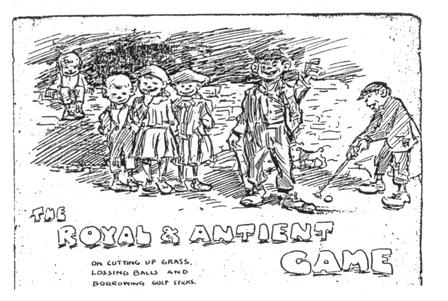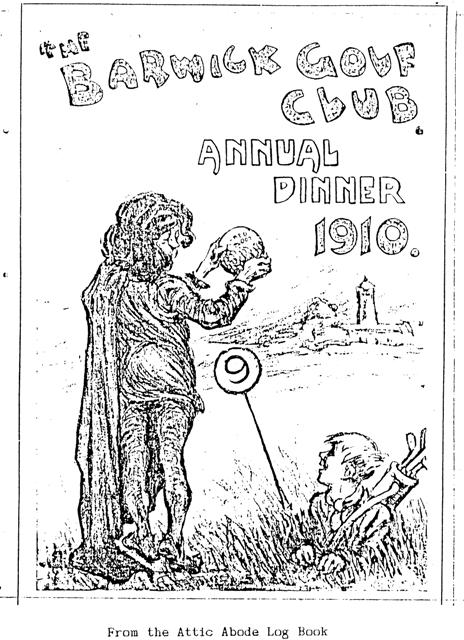Barwick Golf Club
from the Barwicker No. 26
Just over 80 years ago a call of 'two up and half an hour to go', coining from the vicinity of Shaw Lane Fields near Flats Lane, would have alerted nearby residents to sporting activity on the local Barwick golf course, where players were acknowledging progress and the approach of lunch time. Barwick Golf Club was initiated about 1907 by several of the Leeds artists who established the Attic Abode thatched cottage in Main Street as their week-end holiday retreat (see 'The Barwicker No.9).
The artists' Attic Abode Log Book served as an informal record of the short-lived Barwick Golf Club and provides most of the background material on which this article is based. What at first started as a roughly marked practice cum general knock-about area on fields (locally known as 'The Shaws') to the west of Flats Lane, was enterprisingly developed, along with the Inauguration of the golf club, into a creditable nine-hole course. Although the actual layout of the greens, and order of play is uncertain, it is still possible to identify quite a number of slightly raised level areas of ground which formed the original tees.

The activities of the golf club appear to have centred around the Attic Abode, with the thatched cottage serving as an informal club house. An entry by an unknown member in the Attic Abode Log Book dated 1 August 1908 includes the following pen sketch and explanatory text.
 |
"Things are changed. Where a little over a year ago, the village kids would clamour at our doors with 'will yer sketch us?1; now its 'are yer going to lake golf?'. Where we'd talk hours about the pictures of Turner, Constable and Corot, now we hear how Braid was 4 up and 7 to play, knocking spots off the Frenchman Hassy, or Varden bunkered and yet holed out in 5. The cottage is turned into a club-house. One falls over clubs and bags and turns somersaults by treading on old balls. I looked for an easel the other day, but only found some fragments. I hear that the last easel met its fate on a cold spring morning to raise a bit of fire after a noble day's golf." |
The club president, and a founder member, was Mr E.C.Oldham, whose artistic talent was painting. A notable activity of the golf club was the annual dinner, followed some years by plays written in the form of burlesque, by the president Mr Oldham, and performed by fellow club members. In 1907 the annual dinner was held on 6 December at the Gascoigne Arms.

A newspaper article describes the annual dinner and entertainment in 1910 and is beaded:
"BARWICK GOLFERS AHD A NOVEL SORT OF PLAY" |
| "The cheerful philistines of Leeds and district who follow the wee 'ba' around the, as yet, unpretentious golf course of the Berwick Golf Club, held their annual dinner last night, at the Leeds and County Liberal Club. The president of the club, Mr R.C.Oldham, Is nothing if not original. He had decided that the post-prandial proceedings should run an entirely new course. With the co-operation of several of his fellow-members, he produced a highly diverting theatrical extravaganza, of which he himself was the author. Speech-making was limited to two toasts - 'The Barwick Golf Club', proposed by the president and responded to by Mr C.P.Wilson, and 'The Guests' proposed by Mr H.F.Smithson and responded to by Mr A.V.Pullan and Mr Harry Steel. |
| The play was the thing. And such a play! It by no means belied its title of 'Votitisit'. Essentially a mystery play, it turned Shakespearean drama topsy-turvy. Admirably staged with scenery 'from designs that might have been by Burne-Jones1 and with electric effects 'by the Leeds Corporation', the burlesque aroused endless amusement, especially as It kept up a continuous run of topical allusions and playful satire aimed at golfing modes and the characteristics of the Barwick golfers in particular." |
Mr Oldham's play writing for the Barwick Golf Club's annual soirees was to take him to a successful career in the world of theatrical entertainment. Material from his one-act plays came to the attention of the Leeds Grand Theatre management who recognised the quality and originality of his work, and a long series of commissions followed. Although officially engaged by the theatre as a scenic artist, he combined the designing of costumes for ballet scenes, with the writing for 18 years of pantomimes, starting with 'Goody Two Shoes' in 1913, the forerunner of 17 other shows. The writer based his pantomime books on stories never before used, including 'King of the Golden Mountain', 'Tom Tom the Piper's Son' and 'The Three Bears', now a well known favourite. His success in this work earned him the title of 'Yorkshire's uncrowned pantomime-writing king'. The newspaper article continues:
| "The scene was laid at Barwick, and an attempt on the life of Hamlet, after he had arranged a match for the crown and lands of Macbeth, formed the plot. There were skits at all and sundry; Hamlet, indeed, as represented by Mr Oldham, was a jester who trod upon everybody's corns. Shylock (Mr Percy Robinson) was a character composite of wit and villainy; in picking out winners on the links he confessed to having been lynx-eyed. The part of Ophelia, the wanton, was faithfully played by Mr William Jones, and Mr Ernest Forbes made a presentable female as Lady Macbeth. Other individual successes were Mr A Edward Oldbury as Bernardo, Mr E R Grosse as Macbeth 'the rough and ready who wants still more of the latter,' Mr J.A.Goodwin as Frascatino and Mr 'Reggio' Robinson as that picker-up of unconsidered trifles, the caddie. |
| The incidental music was by Mr V A Francis who had also composed for the occasion a tuneful Barwick Golf Club glee, which was sung with great gusto. Mr Oldham as stated was the writer of the play and at the close he made a show of thanking all the members for their many kind and clever suggestions - one of which he had used." |
It apparently proved difficult to keep the golf club going, due the comparative inaccessibility of its rural setting and the limited transport facilities available at the time. To the regret all concerned, the Barwick Golf Club closed in 1911, as the following newspaper article records:
"GOLFING GOSSIP. A Note of Real Regret (By Growler)" |
| "Strictly speaking, perhaps, Barwick scarcely comes within the scope of New Leeds; but many golfers from our district have so many happy recollections on the little nine hole course in the ancient Saxon village, that the passing of the club, after some years of gallant struggling to keep the flag flying, must command first attention. |
| Rarely, if ever, has there been a more sporting or Bohemian organisation than the Barwick Golf club. Originally receiving its impetus from a few Leeds artists and their satellites - who had descended on the village from the city to set up the locally famous 'Attic Abode' -what was first a couple of fields or so very roughly marked out for the knocking about of golf balls, eventually developed into a by no means discreditable nine-hole course. This development followed on the inauguration of the little band as a club; and the free-and-easy carelessly happy manner of the place soon attracted a good company, who more than made up in good fellowship and social enjoyment the playing deficiencies of the course. |
| Unfortunately for Barwick, however, its comparative inaccessibility has been its downfall, and like many another pioneer it is having to go to the wall. A new club has been established at Crossgates and there is another nine-hole course in prospect at Garforth. Further out, of course, is Wetherby; and all these places have the advantage of being situated on the railway. So It comes about that the Barwick club - whose fame has spread far beyond the confines of Leeds - has to give up the ghost. To a good number of players in this district the loss will be a real one; but It Is to be hoped they will all quickly find a new home. It will take a long time, however, to get acclimatised in new surroundings away from the old village. I wonder what the feelings of that Chapeltown good fellow whose call it was at midday on Sunday, 'two up and half an hour to go'. And this was generally down at the New Inn end of the course. |
| But even if the club has to go, It is sincerely to be hoped that the notable annual dinner and Barwick play will not be dlscontinued. The occasion could be used for the re-union of old members every year; and while Mr R.C.Oldham remains It would be folly to allow his facile pen to rest. His previous 'dramatic' efforts have been too good to permit a relinqulshment at this stage. At any rate, here's to the Barwick club - home of good sport and good fellowship." |
The keen golfer had opportunity to pursue the game elsewhere, as the new Cross Gates Golf Club had, at that time, been established on land off Manston Lane. These grounds were, however, later procured for extensions to the Barnbow shell-filling factory in 1917. Garforth Golf Club was opened in 1913, initially with a nine-hole course, and celebrated its 75th anniversary in 1988. Scholes possessed its own golf club, the course being laid out on the field to the east of the village, between Rakehlll Lane and Rakebeck. It is understood that the Barwick Golf Club commemorative shield was displayed in the Gascoigne public house during the 1940s. However It had not been possible to trace this tangible link with a now lost, but not quite forgotten, short-lived village sporting activity.
| Tony Cox |